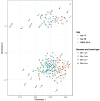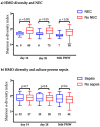Low Diversity of Human Milk Oligosaccharides is Associated with Necrotising Enterocolitis in Extremely Low Birth Weight Infants
- PMID: 30347801
- PMCID: PMC6213888
- DOI: 10.3390/nu10101556
Low Diversity of Human Milk Oligosaccharides is Associated with Necrotising Enterocolitis in Extremely Low Birth Weight Infants
Abstract
Difference in human milk oligosaccharides (HMO) composition in breast milk may be one explanation why some preterm infants develop necrotizing enterocolitis (NEC) despite being fed exclusively with breast milk. The aim of this study was to measure the concentration of 15 dominant HMOs in breast milk during the neonatal period and investigate how their levels correlated to NEC, sepsis, and growth in extremely low birth weight (ELBW; <1000 g) infants who were exclusively fed with breast milk. Milk was collected from 91 mothers to 106 infants at 14 and 28 days and at postmenstrual week 36. The HMOs were analysed with high-performance anion-exchange chromatography with pulsed amperometric detection. The HMOs diversity and the levels of Lacto-N-difucohexaose I were lower in samples from mothers to NEC cases, as compared to non-NEC cases at all sampling time points. Lacto-N-difucohexaose I is only produced by secretor and Lewis positive mothers. There were also significant but inconsistent associations between 3'-sialyllactose and 6'-sialyllactose and culture-proven sepsis and significant, but weak correlations between several HMOs and growth rate. Our results suggest that the variation in HMO composition in breast milk may be an important factor explaining why exclusively breast milk fed ELBW infants develop NEC.
Keywords: breast milk; diversity; growth; necrotizing enterocolitis; neonatal; oligosaccharides; preterm; sepsis.
Conflict of interest statement
The authors declare no conflict of interest. The funders had no role in the design of the study; in the collection, analyses, or interpretation of data; in the writing of the manuscript, and in the decision to publish the results.
Figures




Similar articles
-
Tailoring Human Milk Oligosaccharides to Prevent Necrotising Enterocolitis Among Preterm Infants.Front Nutr. 2021 Jul 29;8:702888. doi: 10.3389/fnut.2021.702888. eCollection 2021. Front Nutr. 2021. PMID: 34395496 Free PMC article. Review.
-
Human milk oligosaccharide composition predicts risk of necrotising enterocolitis in preterm infants.Gut. 2018 Jun;67(6):1064-1070. doi: 10.1136/gutjnl-2016-312819. Epub 2017 Apr 5. Gut. 2018. PMID: 28381523
-
Human milk oligosaccharides differ between HIV-infected and HIV-uninfected mothers and are related to necrotizing enterocolitis incidence in their preterm very-low-birth-weight infants.J Nutr. 2014 Aug;144(8):1227-33. doi: 10.3945/jn.113.187799. Epub 2014 Jun 11. J Nutr. 2014. PMID: 24919691
-
Human milk oligosaccharides in breast milk and 2-year outcome in preterm infants: An exploratory analysis.Clin Nutr. 2022 Sep;41(9):1896-1905. doi: 10.1016/j.clnu.2022.07.024. Epub 2022 Jul 21. Clin Nutr. 2022. PMID: 35944296
-
Human Milk Oligosaccharides to Prevent Gut Dysfunction and Necrotizing Enterocolitis in Preterm Neonates.Nutrients. 2018 Oct 8;10(10):1461. doi: 10.3390/nu10101461. Nutrients. 2018. PMID: 30297668 Free PMC article. Review.
Cited by
-
Tailoring Human Milk Oligosaccharides to Prevent Necrotising Enterocolitis Among Preterm Infants.Front Nutr. 2021 Jul 29;8:702888. doi: 10.3389/fnut.2021.702888. eCollection 2021. Front Nutr. 2021. PMID: 34395496 Free PMC article. Review.
-
The role of human milk nutrients in preventing necrotizing enterocolitis.Front Pediatr. 2023 Jun 2;11:1188050. doi: 10.3389/fped.2023.1188050. eCollection 2023. Front Pediatr. 2023. PMID: 37334221 Free PMC article. Review.
-
Human milk oligosaccharides reduce necrotizing enterocolitis-induced neuroinflammation and cognitive impairment in mice.Am J Physiol Gastrointest Liver Physiol. 2023 Jul 1;325(1):G23-G41. doi: 10.1152/ajpgi.00233.2022. Epub 2023 Apr 25. Am J Physiol Gastrointest Liver Physiol. 2023. PMID: 37120853 Free PMC article.
-
Human Milk Microbiota and Oligosaccharides: A Glimpse into Benefits, Diversity, and Correlations.Nutrients. 2021 Mar 29;13(4):1123. doi: 10.3390/nu13041123. Nutrients. 2021. PMID: 33805503 Free PMC article. Review.
-
Key biologically active components of breast milk and their beneficial effects.Semin Pediatr Surg. 2023 Jun;32(3):151306. doi: 10.1016/j.sempedsurg.2023.151306. Epub 2023 May 30. Semin Pediatr Surg. 2023. PMID: 37276783 Free PMC article. Review.
References
-
- EXPRESS Group. Fellman V., Hellström-Westas L., Norman M., Westgren M., Källén K., Lagercrantz H., Marsál K., Serenius F., Wennergren M. One-year survival of extremely preterm infants after active perinatal care in sweden. JAMA. 2009;301:2225–2233. doi: 10.1097/01.aoa.0000367003.25266.35. - DOI - PubMed
MeSH terms
Substances
Grants and funding
LinkOut - more resources
Full Text Sources

